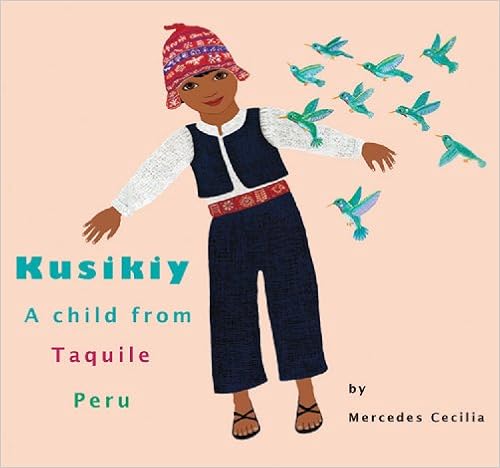Cecilia, Mercedes. Kusikiy: A Child from Taquile, Peru. Keepers of Wisdom and Peace Books, 2010.
Lexile Level: 650L
Book Trailer:
Kusikiy: A Child from Taquile, Peru
tells the story of young boy named Kusikiy. He lives in a small
village on the island of Taquile, in the center of Lake Titicaca.
The village's community has been living a traditional life of
farming, crafting, and animal husbandry, as was taught to their
ancestors by the great spirits that watch over the island. This
year, the rainy season is late on arriving, causing many of the
island's inhabitants to fear that their crops are in danger.
Kusikiy's grandfather tells Kusikiy about the Great Mountain Spirit,
giving Kusikiy the idea to ask the spirit for help. Kusikiy sets off
on an adventure in order to help his village by restoring the rains
that they so desperately need.
Learning Activity
After
reading Kusikiy
together as a class, students will take some time to answer a few
questions about the book in written form. For example: What are some
folktales/myths that you heard during the reading? How did those
myths/folktales affect the people of Taquile? How did Kusikiy use
the folktales/myths of his culture to help his community? How do
some of the folktales/myths compare to stories/folktales that you
have heard before? After collecting our thoughts, we will reconvene
as a class to discuss what we found and share our ideas.
Learning Standard:
CCSS.ELA-LITERACY.RL.3.2
- Recount
stories, including fables, folktales, and myths from diverse
cultures; determine the central message, lesson, or moral and explain
how it is conveyed through key details in the text.
Goal
Kusikiy:
A Child from Taquile, Peru
is essentially a folktale about a child embracing the folktales of
his culture. The author uses the elders of the village to describe
several Taquile fables and folktales to Kusikiy. The goal here is to
encourage students to consider the legends and fables of a different
culture, ideally in comparison to similar ones from their own
culture.
Objective
The
objective of this activity is to help students process the various
folktales told in the book, as well as to organize and identify them,
as well as compare them to folktales they have heard from other
sources.
Outcome
During
our discussion, students should be able to identify multiple
folktales from the story. They should also be able to describe how
the island's residents, as they are portrayed in the text, have
modeled their lives after the lessons taught by their folktales.
Finally, students should be able to link the folktales heard in the
story with folktales that they are already familiar with, primarily
in terms of the lessons that they teach.

No comments:
Post a Comment